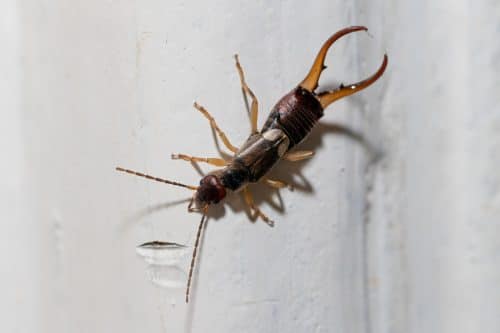Earwigs are weird-looking creatures that received their name from an old European myth that the pest would literally crawl into someone’s ear and eat their brain. Fortunately, this is not true and there are no documented cases of this ever happening. Here’s what is true about earwigs. They can grow up to about an inch in length, have pinchers on the back of their abdomen, crawl on six legs and can be found all over the United States. Usually, reddish-brown or black in color, they have two sets of wings, but normally don’t fly unless it’s a short distance.
Although the pinchers in the back may look scary, they are primarily used for hunting, defense and reproduction. They can pinch humans if they’re picked up, but since they’re not venomous, the pinch generally does nothing more than hurt for a moment. Earwigs are not known to spread disease.
Earwig Habits
Earwigs are not necessarily nocturnal pests, but they do tend to be most active at night. During the day, they are often found in cold, wet areas, such as basements, in mulch, near air conditioners, ditches, etc., but at night they come out to feed on plants, leaves, flowers, fruit, rotting vegetation, moldy areas and insects. Some earwig species target crops and can cause damage.
Earwigs live in large groups, but will go off on their own when the weather changes or there’s a change in food availability. When this happens, earwigs may come indoors through cracks or other exterior openings around doors and windows. Once inside, earwigs are most commonly found near water sources, such as toilets, sinks, showers, bathtubs, kitchens and laundry rooms.
Earwigs Prevention and Control
As with many other pests, the best way to prevent or control earwigs is to eliminate access to the indoors. Seal any cracks or crevices with good silicone caulk, and be sure to check around windows, doors and vents. Because earwigs are attracted to damp areas, removing debris, such as piles of leaves, firewood, etc. from the exterior of the house will reduce the chances for earwigs to come indoors. In basements, a dehumidifier can help reduce moisture and therefore potentially reduce earwigs from the area.
If earwigs are a persistent problem, contact a licensed and trained pest control specialist, like those at United Pest and Turf Control. Our experts will investigate the problem and offer a solution that eliminates the problem while keeping the home and property safe.
What to know about Earwigs in North Alabama and Southern Tennessee
Serving North Central Alabama and South Central Tennessee
Limestone County
Ardmore
Home » What to know about Earwigs


